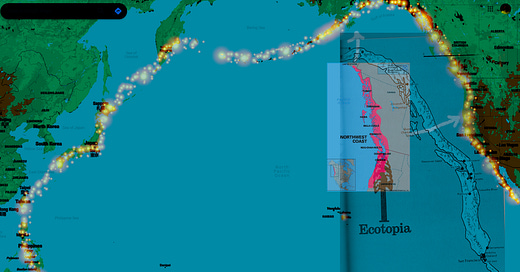Nine Nations - Ecotopia
California, Pacific Northwest, coastal Canada, and Alaska
Although African and European colonial experience is the deep context for the nation’s history on the East Coast and a Eurocentric, East-coast centric dominates a lot of the popular image making, the West Coast has a distinctly different, but just as authentic American experience and context. The story of immigration on the West Coast history is mainly the story of Pacific rim people, many Chinese or Japanese coming to the continent to live. As climate change and other issues escalate, it would not be a surprise to see Pacific rim people immigrating to the Americas through the West Coast.
Joel Garreau delineates the region Ecotopia running roughly from the Bay Area all the way to the tip of Alaska. One way to think of the west coast of America is as the Eastern edge of the Pacific rim as much as part of the mainland continent. The Rocky Mountains especially cut off the coastal areas from the valleys. In a naval faring age, a person in San Francisco may be ‘closer’ to the southern tip of Baja, or even Shanghai, than Sacramento. That sense of distance may be hard to imagine in the age of highway and air travel. The irony is that the romanticized old west is what gives modern America its eastern bent. [1]
Today the people and their perspectives on ways of life and values are naturally divided by the land. To the coastal side, the values of Ecotopia bend toward making a business out of Utopia. It is the coastal side where California gets its reputation as a liberal wacko state. On the other side of the Rocky Mountains are the valley people. Rock ribbed. Conservative. Agricultural. Whatever the case, one may place the nation that the Nine Nations project sketched out as the distinct Ecotopia right over the Pacific Northwest native peoples. On that note, the author confesses that although spent significant time living in Ecotopia learned little of the native peoples to go beyond drawing the maps. The next step in my path is to continue learning. That closes this series - it started upon noting the startling similarities to the lines that Mr. Garreau and his journalist cohorts drew over the Native Peoples nations.
Time to leave it at that. I hope you enjoyed this series of essays ‘A Native People’s History of the United States’. :)
Notes
[1]
If one does not recognize the classic Spaghetti western vibe of Golden Swallow coolly flipping the bar keep a coin and announcing her intention to rent a room after besting a gang of Jade Tiger’s bandits in the inn’s saloon - then consider as proof the direct linkage of Akira Kurosowa’s credit as the inspiration for your favorite spaghetti western. The 7 Samurai begot The Magnificent 7 and so on. 10 Western Films Influenced By Akira Kurosawa's Movies (screenrant.com)
Today the East’s influence is felt across the American pop-commercial landscape from the American sport of Mixed Martial Arts (a west coast first phenomena seeking the challenge the East Coast -British sport of Boxing) down to the now standard neighborhood dojo and Chinese or Sushi takeout. Some predict Asian fashion trends to shortly takeover the American fashion sense. We’ll see.
References
Northwest Coast Indians - Students | Britannica Kids | Homework Help
Garreau, Joel. The Nine Nations of North America. 1st ed., Avon Books, 1981.
https://indigenouspeoplesresources.com/




